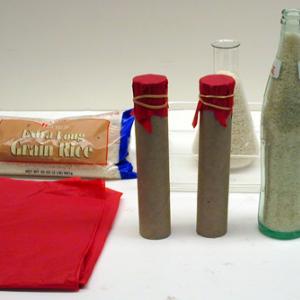College of Liberal Arts & Sciences
1J30.70 - Rice in a Tube
Fill the pop bottle to the very top with rice. Plunge the wooden dowel into the pop bottle without turning. The pressure exerted on the dowel by the rice should be enough that you can lift the pop bottle off of the table with the wooden dowel. Twisting the dowel will release it so that you can remove it from the pop bottle.
Cover one end of the cardboard tube with a section of tissue paper and hold in place with a rubber band. Fill the tube with rice. No matter how hard you push on top of the rice with your finger you cannot exert enough pressure to break the tissue paper at the bottom of the tube.
- Piotr Habdas, Eric R. Weeks, and David G. Lynn, "Squishy Materials", TPT, Vol. 44, # 5, May 2006, p. 276.
- Martin Gardner, "Physics Trick of the Month - The Unbroken Tissue", TPT, Vol. 39, # 7, p. 435, Oct. 2001.
- Martin Gardner, "Physics Trick of the Month - Suspended Bottle", TPT, Vol. 39, # 4, p. 254, April 2001.
- F- 070, "Lifting Rice with Screwdriver", DICK and RAE Physics Demo Notebook.
- Martin Gardner, "20, The Unbroken Tissue", Smart Science Tricks, p. 35.
- Martin Gardner, "23, The Suspended Bottle", Smart Science Tricks, p. 39.
- Martin Gardner, "Suspended Rice", Entertaining Science Experiments with Everyday Objects, p. 95.
- Vicki Cobb and Kathy Darling, "Fakir Fakeout", Bet You Can!, p. 90.
- Vicki Cobb and Kathy Darling, "Strong Arm Tactics", Bet You Can!, p. 84.
- Jearl Walker, "2.125, Lifting Rice With a Rod", The Flying Circus of Physics Ed. 2, p. 136.
- Tik L. Liem, "The Sticky Knife", Invitations to Science Inquiry - Supplement to 1st and 2nd Ed. p. 120.
Disclaimer: These demonstrations are provided only for illustrative use by persons affiliated with The University of Iowa and only under the direction of a trained instructor or physicist. The University of Iowa is not responsible for demonstrations performed by those using their own equipment or who choose to use this reference material for their own purpose. The demonstrations included here are within the public domain and can be found in materials contained in libraries, bookstores, and through electronic sources. Performing all or any portion of any of these demonstrations, with or without revisions not depicted here entails inherent risks. These risks include, without limitation, bodily injury (and possibly death), including risks to health that may be temporary or permanent and that may exacerbate a pre-existing medical condition; and property loss or damage. Anyone performing any part of these demonstrations, even with revisions, knowingly and voluntarily assumes all risks associated with them.
